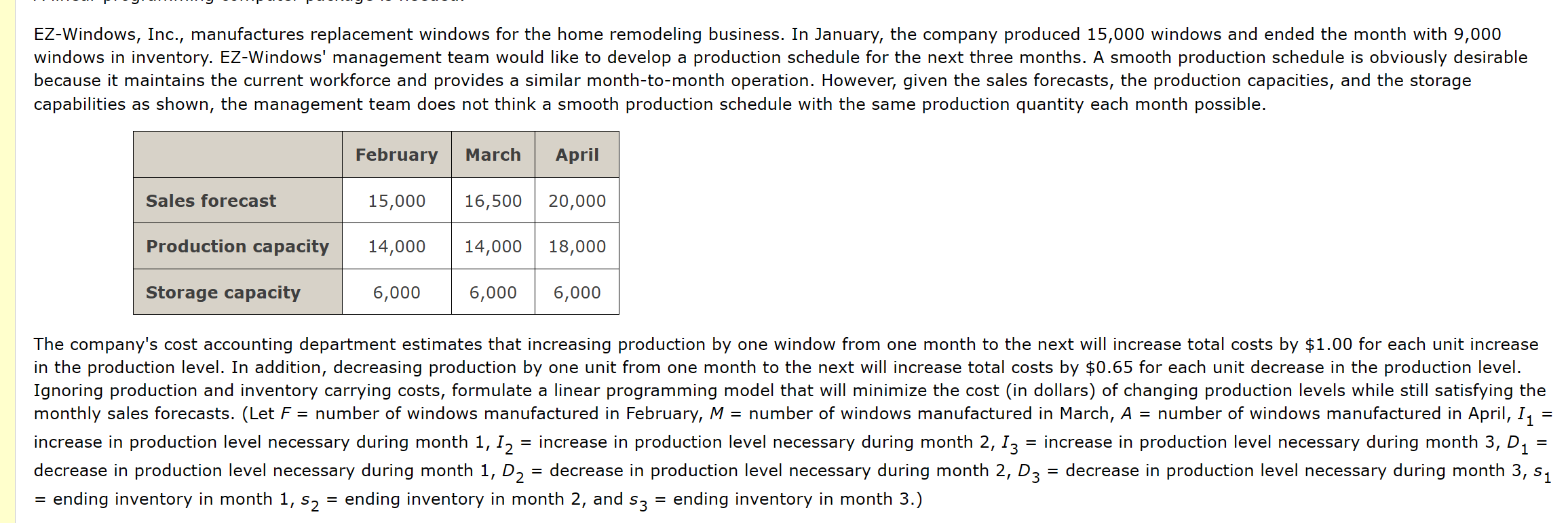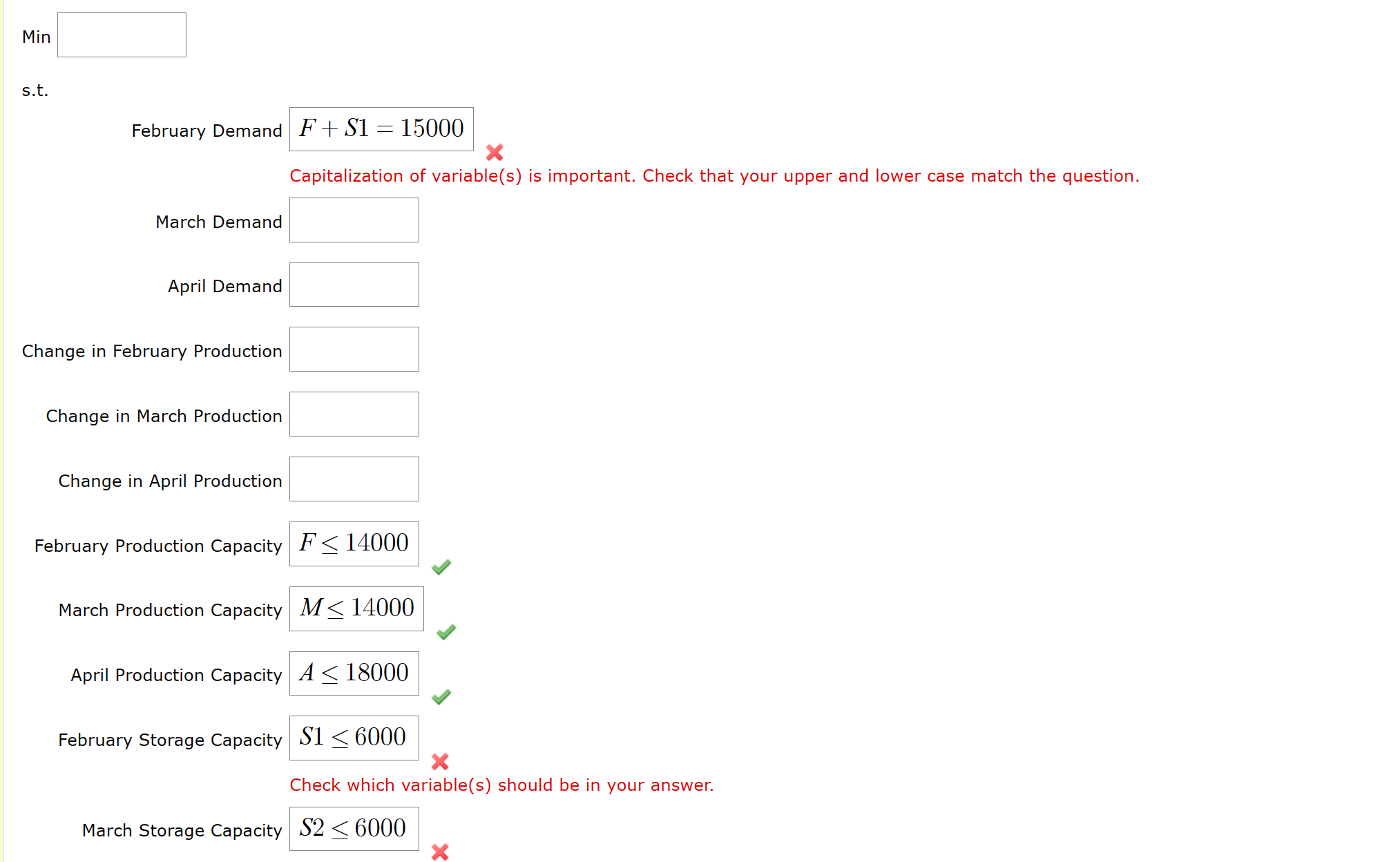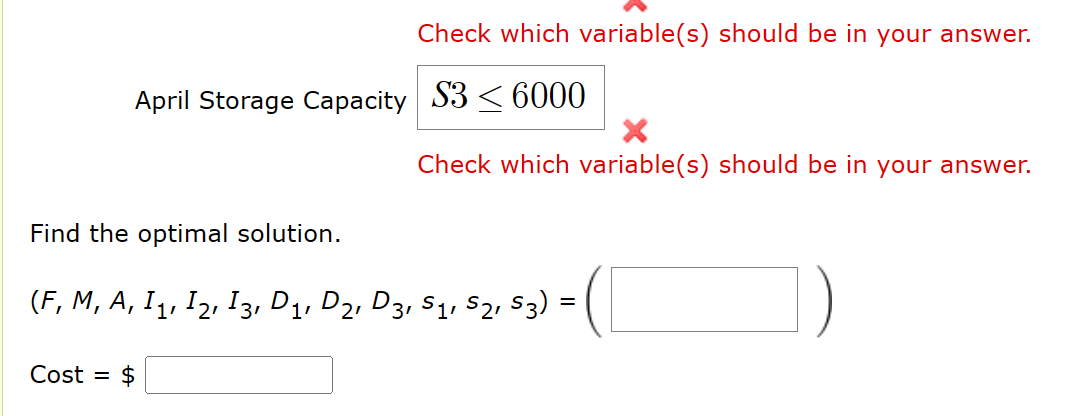Answered step by step
Verified Expert Solution
Question
1 Approved Answer
s.t. February Demand F+S1=15000 Capitalization of variable(s) is important. Check that your upper and lower case match the question. March Demand April Demand Change in


 s.t. February Demand F+S1=15000 Capitalization of variable(s) is important. Check that your upper and lower case match the question. March Demand April Demand Change in February Production Change in March Production Change in April Production February Production Capacity March Production Capacity April Production Capacity February Storage Capacity Check which variable(s) should be in your answer. March Storage Capacity S26000 EZ-Windows, Inc., manufactures replacement windows for the home remodeling business. In January, the company produced 15,000 windows and ended the month with 9,000 windows in inventory. EZ-Windows' management team would like to develop a production schedule for the next three months. A smooth production schedule is obviously desirable because it maintains the current workforce and provides a similar month-to-month operation. However, given the sales forecasts, the production capacities, and the storage capabilities as shown, the management team does not think a smooth production schedule with the same production quantity each month possible. The company's cost accounting department estimates that increasing production by one window from one month to the next will increase total costs by $1.00 for each unit increase in the production level. In addition, decreasing production by one unit from one month to the next will increase total costs by $0.65 for each unit decrease in the production level. Ignoring production and inventory carrying costs, formulate a linear programming model that will minimize the cost (in dollars) of changing production levels while still satisfying the monthly sales forecasts. (Let F= number of windows manufactured in February, M= number of windows manufactured in March, A= number of windows manufactured in April, I1= increase in production level necessary during month 1,I2= increase in production level necessary during month 2,I3= increase in production level necessary during month 3,D1= decrease in production level necessary during month 1,D2= decrease in production level necessary during month 2,D3= decrease in production level necessary during month 3,s1 = ending inventory in month 1,s2= ending inventory in month 2 , and s3= ending inventory in month 3 .) Check which variable(s) should be in your answer. April Storage Capacity Check which variable(s) should be in your answer. Find the optimal solution. (F,M,A,I1,I2,I3,D1,D2,D3,s1,s2,s3)=(Cost=$ s.t. February Demand F+S1=15000 Capitalization of variable(s) is important. Check that your upper and lower case match the question. March Demand April Demand Change in February Production Change in March Production Change in April Production February Production Capacity March Production Capacity April Production Capacity February Storage Capacity Check which variable(s) should be in your answer. March Storage Capacity S26000 EZ-Windows, Inc., manufactures replacement windows for the home remodeling business. In January, the company produced 15,000 windows and ended the month with 9,000 windows in inventory. EZ-Windows' management team would like to develop a production schedule for the next three months. A smooth production schedule is obviously desirable because it maintains the current workforce and provides a similar month-to-month operation. However, given the sales forecasts, the production capacities, and the storage capabilities as shown, the management team does not think a smooth production schedule with the same production quantity each month possible. The company's cost accounting department estimates that increasing production by one window from one month to the next will increase total costs by $1.00 for each unit increase in the production level. In addition, decreasing production by one unit from one month to the next will increase total costs by $0.65 for each unit decrease in the production level. Ignoring production and inventory carrying costs, formulate a linear programming model that will minimize the cost (in dollars) of changing production levels while still satisfying the monthly sales forecasts. (Let F= number of windows manufactured in February, M= number of windows manufactured in March, A= number of windows manufactured in April, I1= increase in production level necessary during month 1,I2= increase in production level necessary during month 2,I3= increase in production level necessary during month 3,D1= decrease in production level necessary during month 1,D2= decrease in production level necessary during month 2,D3= decrease in production level necessary during month 3,s1 = ending inventory in month 1,s2= ending inventory in month 2 , and s3= ending inventory in month 3 .) Check which variable(s) should be in your answer. April Storage Capacity Check which variable(s) should be in your answer. Find the optimal solution. (F,M,A,I1,I2,I3,D1,D2,D3,s1,s2,s3)=(Cost=$
s.t. February Demand F+S1=15000 Capitalization of variable(s) is important. Check that your upper and lower case match the question. March Demand April Demand Change in February Production Change in March Production Change in April Production February Production Capacity March Production Capacity April Production Capacity February Storage Capacity Check which variable(s) should be in your answer. March Storage Capacity S26000 EZ-Windows, Inc., manufactures replacement windows for the home remodeling business. In January, the company produced 15,000 windows and ended the month with 9,000 windows in inventory. EZ-Windows' management team would like to develop a production schedule for the next three months. A smooth production schedule is obviously desirable because it maintains the current workforce and provides a similar month-to-month operation. However, given the sales forecasts, the production capacities, and the storage capabilities as shown, the management team does not think a smooth production schedule with the same production quantity each month possible. The company's cost accounting department estimates that increasing production by one window from one month to the next will increase total costs by $1.00 for each unit increase in the production level. In addition, decreasing production by one unit from one month to the next will increase total costs by $0.65 for each unit decrease in the production level. Ignoring production and inventory carrying costs, formulate a linear programming model that will minimize the cost (in dollars) of changing production levels while still satisfying the monthly sales forecasts. (Let F= number of windows manufactured in February, M= number of windows manufactured in March, A= number of windows manufactured in April, I1= increase in production level necessary during month 1,I2= increase in production level necessary during month 2,I3= increase in production level necessary during month 3,D1= decrease in production level necessary during month 1,D2= decrease in production level necessary during month 2,D3= decrease in production level necessary during month 3,s1 = ending inventory in month 1,s2= ending inventory in month 2 , and s3= ending inventory in month 3 .) Check which variable(s) should be in your answer. April Storage Capacity Check which variable(s) should be in your answer. Find the optimal solution. (F,M,A,I1,I2,I3,D1,D2,D3,s1,s2,s3)=(Cost=$ s.t. February Demand F+S1=15000 Capitalization of variable(s) is important. Check that your upper and lower case match the question. March Demand April Demand Change in February Production Change in March Production Change in April Production February Production Capacity March Production Capacity April Production Capacity February Storage Capacity Check which variable(s) should be in your answer. March Storage Capacity S26000 EZ-Windows, Inc., manufactures replacement windows for the home remodeling business. In January, the company produced 15,000 windows and ended the month with 9,000 windows in inventory. EZ-Windows' management team would like to develop a production schedule for the next three months. A smooth production schedule is obviously desirable because it maintains the current workforce and provides a similar month-to-month operation. However, given the sales forecasts, the production capacities, and the storage capabilities as shown, the management team does not think a smooth production schedule with the same production quantity each month possible. The company's cost accounting department estimates that increasing production by one window from one month to the next will increase total costs by $1.00 for each unit increase in the production level. In addition, decreasing production by one unit from one month to the next will increase total costs by $0.65 for each unit decrease in the production level. Ignoring production and inventory carrying costs, formulate a linear programming model that will minimize the cost (in dollars) of changing production levels while still satisfying the monthly sales forecasts. (Let F= number of windows manufactured in February, M= number of windows manufactured in March, A= number of windows manufactured in April, I1= increase in production level necessary during month 1,I2= increase in production level necessary during month 2,I3= increase in production level necessary during month 3,D1= decrease in production level necessary during month 1,D2= decrease in production level necessary during month 2,D3= decrease in production level necessary during month 3,s1 = ending inventory in month 1,s2= ending inventory in month 2 , and s3= ending inventory in month 3 .) Check which variable(s) should be in your answer. April Storage Capacity Check which variable(s) should be in your answer. Find the optimal solution. (F,M,A,I1,I2,I3,D1,D2,D3,s1,s2,s3)=(Cost=$ Step by Step Solution
There are 3 Steps involved in it
Step: 1

Get Instant Access to Expert-Tailored Solutions
See step-by-step solutions with expert insights and AI powered tools for academic success
Step: 2

Step: 3

Ace Your Homework with AI
Get the answers you need in no time with our AI-driven, step-by-step assistance
Get Started


